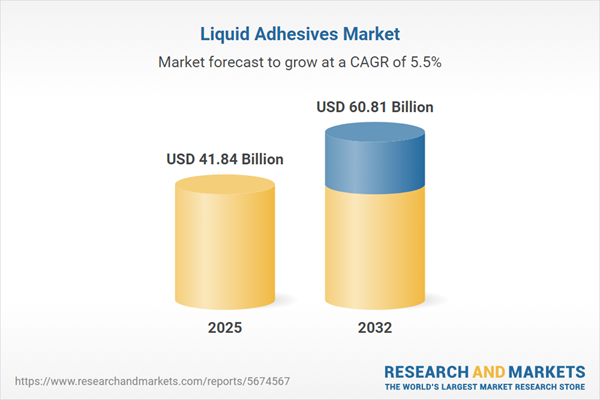Speak directly to the analyst to clarify any post sales queries you may have.
The liquid adhesives market is evolving rapidly, shaped by technological advancements and shifting end-user needs. Decision-makers navigating this dynamic sector require actionable insights to align innovation, supply chain, and sustainability strategies for future growth.
Market Snapshot: Liquid Adhesives Market Trends and Size
The liquid adhesives market grew from USD 39.66 billion in 2024 to USD 41.84 billion in 2025. It is projected to expand at a CAGR of 5.48%, reaching USD 60.81 billion by 2032. Demand is propelled by advancements in manufacturing, sustainability priorities, and the adoption of digital process controls across a wide range of industries including automotive, construction, electronics, packaging, and healthcare. As new application techniques and innovative chemistries arise, suppliers and end-users alike are recalibrating product portfolios to keep pace with regulatory expectations and evolving material needs.
Scope & Segmentation: Coverage of Technologies, End-Uses, Polymers, and Application Modes
- Technology: Hot melt, pressure sensitive, reactive, solvent based, UV curable, water based
- End Use: Construction, consumer goods, electronics, medical and healthcare, packaging, transportation and automotive, woodworking and furniture
- Polymer Type: Acrylic, epoxy, ethylene vinyl acetate, polyolefin, polyurethane, rubber, silicone
- Application Mode: Brush, dip, extrusion, roll coating, spray
- Regions: Americas (United States, Canada, Mexico, Brazil, Argentina, Chile, Colombia, Peru), Europe, Middle East & Africa (UK, Germany, France, Russia, Italy, Spain, Netherlands, Sweden, Poland, Switzerland, UAE, Saudi Arabia, Qatar, Turkey, Israel, South Africa, Nigeria, Egypt, Kenya), Asia-Pacific (China, India, Japan, Australia, South Korea, Indonesia, Thailand, Malaysia, Singapore, Taiwan)
- Companies Analyzed: Henkel, Sika, 3M, H.B. Fuller, Dow, Avery Dennison, Arkema, Eastman, RPM International, BASF
Key Takeaways for Senior Decision-Makers
- Advanced chemistries now enable liquid adhesives to deliver rapid curing, precise viscosity control, and functional performance for demanding assembly processes.
- Manufacturers are shifting from traditional solvent-based systems to water-based and UV-curable formulations to meet environmental and regulatory requirements while optimizing production output.
- The implementation of digital manufacturing and inline monitoring is improving bond quality, reducing waste, and supporting predictive process maintenance in high-volume industries.
- Regional adaptation is crucial; markets in North America, Europe, Asia-Pacific, and emerging economies present unique demands based on regulatory landscapes, application focus, and industrialization rates.
- Collaborative innovation and supply chain diversification are becoming vital as the industry responds to disruptive geopolitical events and rising sustainability expectations.
- The competitive environment is driven by companies expanding sustainable sourcing, specialized applications, and technical support to differentiate their offerings and pursue market expansion.
Tariff Impact on Supply Chains and Costs
New tariffs introduced in the United States in 2025 have significantly impacted the liquid adhesives sector by altering raw material sourcing, cost structures, and logistics. Manufacturers have accelerated near-shoring and regional diversification and are investing in alternative chemistries less reliant on tariff-affected feedstocks. This shift enhances supply chain resilience but drives collaboration between suppliers and end-users and influences strategic joint ventures across global markets.
Methodology & Data Sources
This report utilizes a robust mixed-method approach, combining primary research—such as executive interviews and on-site facility visits—with secondary analysis from corporate filings, patents, regulatory databases, and industry publications. Findings are validated through data triangulation and expert review to ensure reliability and actionable guidance for market participants.
Why This Report Matters
- Provides an up-to-date, segmented outlook on liquid adhesives, helping executives identify technology and application trends shaping global competition.
- Delivers strategic insights into the effects of regulatory, economic, and sustainability shifts, enabling informed decision-making in dynamic business environments.
- Highlights opportunities for product portfolio enhancements and operational improvements through supply chain and innovation alignment.
Conclusion
The liquid adhesives market is being reshaped by new materials, digital tools, and region-specific factors. Leaders who prioritize sustainability, digital process integration, and resilient partnerships will be well positioned to tap into growth and deliver value in evolving global markets.
Additional Product Information:
- Purchase of this report includes 1 year online access with quarterly updates.
- This report can be updated on request. Please contact our Customer Experience team using the Ask a Question widget on our website.
Table of Contents
3. Executive Summary
4. Market Overview
7. Cumulative Impact of Artificial Intelligence 2025
Companies Mentioned
The companies profiled in this Liquid Adhesives market report include:- Henkel AG & Co. KGaA
- Sika AG
- 3M Company
- H.B. Fuller Company
- Dow Inc.
- Avery Dennison Corporation
- Arkema SA
- Eastman Chemical Company
- RPM International Inc.
- BASF SE
Table Information
| Report Attribute | Details |
|---|---|
| No. of Pages | 198 |
| Published | October 2025 |
| Forecast Period | 2025 - 2032 |
| Estimated Market Value ( USD | $ 41.84 Billion |
| Forecasted Market Value ( USD | $ 60.81 Billion |
| Compound Annual Growth Rate | 5.4% |
| Regions Covered | Global |
| No. of Companies Mentioned | 11 |









